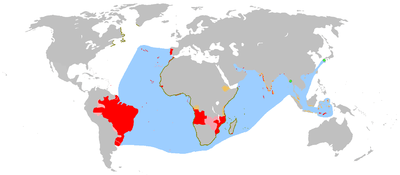Portuguese Ceylon
Portuguese Ceylon (Portuguese: Ceilão Português) was a Portuguese territory in present-day Sri Lanka, representing a period in Sri Lankan history from 1505–1658. The Portuguese first encountered the Ceylonese kingdom of Kotte, with whom they signed a treaty. Portuguese Ceylon was established through the occupation of Kotte and the conquest of surrounding Sinhalese kingdoms. In 1565 the capital of Portuguese Ceylon was moved from Kotte to Colombo. Christianization attempts by the Portuguese furthered friction with the Sinhalese people.
Eventually, the Ceylonese sought help from the Dutch Empire in their struggle for liberation. The Dutch Empire initially entered into agreement with the Kingdom of Kandy. After the collapse of the Iberian economy in 1627, and the breakup of Spain as a united kingdom after the secession of Portugal in 1640, the Dutch-Portuguese War saw the Dutch conquest of Portugal's Asiatic colonies. Eventually, Portugal's Ceylonese territories were ceded to the Netherlands. Nevertheless, there remain elements of Portuguese culture in Sri Lanka today from this colonial period.
Part of a series on the |
|---|
| History of Kandy |
 |
|
Kingdom of Kandy (1469–1815) |
|---|
|
|
|
Colonial Kandy (1815–1948) |
|---|
|
|
|
Kandy (1948–present) |
|---|
|
|
|
See also |
|---|
|
|
|
Sri Lanka portal |
|
See also
References
- Ceylon and the Portuguese, 1505-1658 (1920). Author: Pieris, P. E. (Paulus Edward), 1874-; Naish, Richard Bryant, 1891- Subject: Sri Lanka -- History
- Portuguese History in Ceylon
- C. Gaston Pereira, Kandy fights the Portuguese. Sri Lanka: Vijitha Yapa Publications, July 2007. ISBN 978-955-1266-77-6
- Channa Wicremasekera, Kandy at War. Sri Lanka: Vijitha Yapa Publications, 2004. ISBN 955-8095-52-4
- Michael Roberts, Sinhala Consciousness in the Kandyan Period. Sri Lanka: Vijitha Yapa Publications, 2004. ISBN 955-8095-31-1,
- Abeysinghe, Tikiri (2005). Jaffna under the Portuguese. Colombo: Stamford Lake. p. 66. ISBN 955-1131-70-1.
- Kunarasa, K (2003). The Jaffna Dynasty. Johor Bahru: Dynasty of Jaffna King’s Historical Society. p. 122. ISBN 955-8455-00-8.
- Gnanaprakasar, Swamy (2003). A Critical History of Jaffna (review of Yalpana Vaipava Malai). New Delhi: Asian Educational Services. p. 122. ISBN 81-206-1686-3.
- Senaka Weeraratna, Repression of Buddhism in Sri Lanka by the Portuguese (1505 - 1658)(http://vgweb.org/unethicalconversion/port_rep.htm)2005
|
|---|
| | History | |
|---|
| Politics &
Government | Law | |
|---|
| Legislature | |
|---|
| Judiciary | |
|---|
| Executive | |
|---|
| Military | |
|---|
|
|---|
| | Economy | |
|---|
| | Society | Culture | |
|---|
| | |
|---|
| Related peoples | |
|---|
| | |
|---|
| Influence | |
|---|
| | |
|---|
|
|---|
| | Other | |
|---|
|  Category |
|
|
|---|
| | North Africa |
|---|
|
|
15th century
|
16th century
|
|
| | | | Sub-Saharan Africa |
|---|
|
|
15th century
|
16th century
|
17th century
18th century
19th century
|
|
| | | Southwest Asia |
|---|
|
|
16th century
|
17th century
|
|
| | | Indian subcontinent |
|---|
|
|
15th century
16th century
Portuguese India
|
|
17th century
Portuguese India
18th century
Portuguese India
|
|
| | | East Asia and Oceania |
|---|
|
|
16th century
17th century
|
19th century
Portuguese Macau
20th century
Portuguese Macau
| • 1938–1941 | Lapa and Montanha (Hengqin)
|
|
- 1 1975 is the year of East Timor's Declaration of Independence and subsequent invasion by Indonesia. In 2002, East Timor's independence was fully recognized.
|
| | | North America and the North Atlantic Ocean |
|---|
|
|
15th century
|
16th century
|
|
|
| | | Central and South America |
|---|
|
|
16th century
|
17th century
18th century
|
19th century
|
|
| | |
|


.svg.png)
